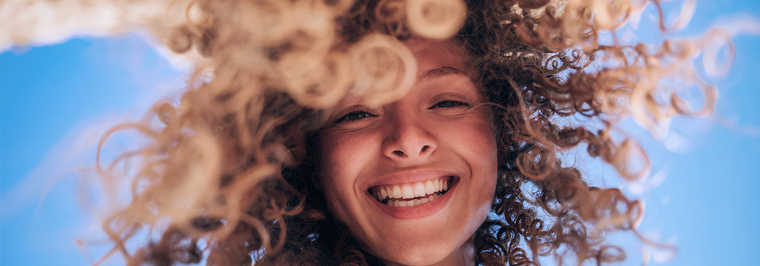AESTHETE Dental Clinic offers veneer installation services. We have experienced, highly qualified doctors who use the Magicneers technology, which eliminates discomfort and pain as no preliminary grinding is required. We explain what types of veneers exist and their advantages.
Veneers – What are they?
Back in the late 1920s, a California dentist named Charles Pincus suggested that Hollywood actors attach covers to their teeth to mask aesthetic defects during filming. Initially, these plates were temporarily installed, but as technology progressed, dentists developed permanent coverings that could last for several years on the surface of teeth. This is how veneers were born. Initially, only wealthy individuals could afford them, but now they have become more accessible.

Veneers are thin plates made of ceramics or other materials. They are fixed on the front surfaces of teeth to mask aesthetic imperfections:
- stains and dark spots on enamel;
- small chips, cracks, grooves;
- slight bite defects;
- wide gaps between teeth.
Veneers are not for treating teeth, but exclusively for improving the aesthetics of a smile. In the presence of serious problems, such as broken teeth or significant bite defects, veneers will not help.
However, ceramic veneers are suitable for those who have no medical need for full treatment. They offer a way to delight others with a dazzling smile. They are often installed for people who need to perform in front of an audience, such as show business representatives, lecturers, and politicians. Businesspeople attending negotiations or managers leading meetings also use them.
Veneers are usually installed for individuals aged 18 and older. Children and teenagers still have developing dental systems, so veneers might not stay in place, shift, or fall off.
What Types of Veneers Exist?
Modern aesthetic dentistry uses various types of veneers. This allows for solutions tailored to each patient's individual features and needs. Veneers differ in the materials from which they are made and the method of installation.
Composite Veneers
The simplest type of veneers, installed directly, are composite veneers (also called therapeutic veneers). They are made from a photo-polymer composite, a light-cured material used for fillings. These veneers are applied directly to the patient's teeth during a dental visit. The dentist applies a layer of the composite material and uses a UV lamp to harden it immediately.
Advantages:
- Time-saving – depending on the amount of work, the installation usually takes from 1-2 hours to 2-3 days;
- Lower cost compared to other types of veneers;
- No need for preliminary tooth preparation – though this is not always possible, and it depends on the patient's dental condition;
- Easy restoration – if small chips or cracks appear, they can be repaired using the same composite material.
Disadvantages:
- Relatively short lifespan – up to 4-5 years;
- Quick discoloration – the material can absorb staining substances from food and drinks, and darken due to tobacco smoke exposure.
Ceramic Veneers
Ceramic veneers are installed using an indirect method. First, the dentist takes impressions of the teeth, then a lab creates the veneers based on those impressions. These veneers are also called orthopedic veneers.

Ceramic veneers are made from porcelain, feldspar ceramics, and other similar materials. Various techniques are used to process these materials, including:
- hot pressing;
- cutting from a pre-made block.
The veneers are then attached to the teeth using dental cement for reliable fixation.
Porcelain, feldspar ceramics, and lithium disilicate glass ceramics are strong, hypoallergenic materials that eliminate the need for a metal base. Pressing and high-temperature processing increase their strength and lifespan.
Pressed veneers are thicker but stronger, while cast veneers are thinner.
If ceramic veneers are installed using the traditional method, tooth preparation is necessary. The teeth are filed to create a smooth surface, which improves the fit of the veneers. This process can be painful and uncomfortable. Additionally, patients must wear temporary plastic veneers until the permanent ones are ready, and these are not very convenient to use. Another drawback is that once the tooth structure is removed, it cannot be reversed. Without veneers, the teeth may experience discomfort from hot, cold, or sweet foods.
Advantages:
- Excellent aesthetic properties – these veneers are hard to distinguish from natural teeth;
- Long lifespan – 10-15 years or more with proper daily oral care;
- High strength – the material can withstand strong mechanical forces;
- Stain resistance – the color does not change after prolonged use.
Disadvantages:
- Higher cost compared to direct veneers;
- Installation takes 2-3 weeks;
- Irreparable – damaged veneers must be replaced with new ones;
- Requires tooth preparation, which can be painful (when using the traditional method).
Can Veneers be Installed Without Grinding?

The AESTHETE dental clinic uses the patented Magicneers technology, which allows veneers to be installed without grinding the teeth. This method provides excellent aesthetic results, while also ensuring that:
- The patient experiences no pain or discomfort;
- There is no need to wear uncomfortable temporary plastic veneers.
The installation uses an indirect method, requiring only three visits to the clinic.
During the first visit, the dentist takes diagnostic impressions and conducts a photoshoot to analyze the patient's smile.
The second visit is for fitting a wax model of the future veneers, selecting their color and shape. After this, the final impressions are taken.
The third visit is for the final installation. The dentist fixes the veneers on the patient's teeth, leaving them with a stunning white smile.
We install hand-crafted veneers that look incredibly realistic. They feature:
- Volume and deep color;
- Natural micro-relief surface;
- Thin, translucent cutting edges.
We use advanced technologies in the clinic, such as CT diagnostics and 3D scanner impressions. The creation of a digital smile design using special software ensures a predictable result.
After the veneers are installed, you will receive a digital certificate confirming their authenticity, which contains information about the work done, including the dental formula, 3D copies of the veneers, doctor details, and the technique used.
Zirconia Veneers
Another type of veneers is zirconia-based. Zirconium dioxide is a durable, hypoallergenic material used in dentistry to make crowns. Strictly speaking, zirconia is used to make the framework for the veneers, which is then covered with ceramic. This results in extremely strong, durable veneers that are installed indirectly.
Advantages:
- Lifespan up to 20 years;
- Impeccable aesthetics;
- Stain resistance from food and beverages.
Disadvantages:
- High cost due to the difficulty of processing zirconia;
- Irreparable – this is true for all indirectly installed products;
- Multiple clinic visits required; installation takes 2-3 weeks;
- Involves tooth preparation, which can cause discomfort and pain.
Composites Veneers
This type of veneer combines elements of both direct and indirect installation methods.
Composite veneers are made from composite material, but unlike direct veneers, the material is not applied to the teeth in layers using a UV lamp. Instead, the dentist uses pre-made composite plates, which they select based on size, color, and shape requirements.
As with the indirect method, these veneers are fixed to the teeth with dental adhesive. Usually, tooth preparation is required, but this depends on the patient's condition.
Advantages:
- Time-saving – the procedure can be completed in a single visit, usually taking 1-5 hours depending on the complexity;
- No need to take impressions or involve a lab, which reduces costs;
- Color selection can be personalized according to the patient's preference.
Disadvantages:
- Short lifespan – 4-7 years (approximate data, as composites have only recently entered the market);
- Low repairability – a damaged veneer needs to be replaced entirely;
- Susceptible to color changes from food dyes and tobacco smoke – if only the surface discolors, it can be polished, but frequent polishing can wear down the thin veneers.
Lumineers
Lumineers are essentially the same as veneers, but thinner. The name "Lumineers" is patented and can only be used by a few labs in the US.

Typically, veneers are 0.5-1.5 mm thick, while Lumineers are only 0.2 mm thick.
These veneers are installed using an indirect method. Impressions are taken, then the lab creates the veneers, followed by installation. The technology creators claim that tooth preparation is not required, but this is not always the case. If the enamel surface does not meet the requirements, some grinding will still be necessary.
Advantages:
- Excellent aesthetic characteristics;
- Long lifespan, despite the thinness – up to 15-20 years;
- Installation with minimal or no tooth preparation.
Disadvantages:
- High cost – one of the most expensive types of veneers;
- Not all aesthetic defects can be hidden with Lumineers – further details are provided below.
Since the plates are thin, they are translucent. As a result, wide gaps between teeth, severely darkened fillings, or parts of enamel can still be visible, even with the veneers. Lumineers are recommended for:
- Small chips or cracks;
- Not-too-wide gaps between teeth;
- Fluorosis;
- Small teeth;
- Unattractive enamel shade that won’t show through the translucent veneers.
Palatal Veneers
Typically, ceramic or composite veneers are fixed to the front surfaces of the teeth. However, there is another type of veneer called palatal veneers. These are fixed to the palatal surface of the upper jaw teeth – the one facing the roof of the mouth.
Palatal veneers are more commonly used for therapeutic than medical purposes. They help reduce tooth wear or protect the pulp if enamel or dentin layers are damaged.
In this case, ceramics, composites, or metals may be used. The choice of material depends on the clinical situation and the patient's individual features. Preliminary grinding is not always necessary, as surface erosion caused by wear or other
Referense
- Alothman Y, Bamasoud MS. The Success of Dental Veneers According To Preparation Design and Material Type. Open Access Maced J Med Sci. 2018;6(12):2402-2408.
- Calamia J. The etched porcelain veneer technique. The New York state dental journal. 1988;54(7):48. PMid:3050646.
- Hui K, et al. A comparative assessment of the strengths of porcelain veneers for incisor teeth dependent on their design characteristics. British dental journal. 1991;171(2):51–55.
- Faunce F, Faunce A. The use of laminate veneers for restoration of fractured or discolored teeth. Texas dental journal. 1975;93(8):6–7.














